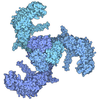[English] 日本語
 Yorodumi
Yorodumi- PDB-9oa8: Cryo-EM structure of KCa3.1/calmodulin channel in complex with NS309 -
+ Open data
Open data
- Basic information
Basic information
| Entry | Database: PDB / ID: 9oa8 | ||||||||||||||||||||||||||||||||||||
|---|---|---|---|---|---|---|---|---|---|---|---|---|---|---|---|---|---|---|---|---|---|---|---|---|---|---|---|---|---|---|---|---|---|---|---|---|---|
| Title | Cryo-EM structure of KCa3.1/calmodulin channel in complex with NS309 | ||||||||||||||||||||||||||||||||||||
 Components Components |
| ||||||||||||||||||||||||||||||||||||
 Keywords Keywords | TRANSPORT PROTEIN / Ion channel / Intermediate conductance calcium-activated potassium channel / Calmodulin binding protein | ||||||||||||||||||||||||||||||||||||
| Function / homology |  Function and homology information Function and homology informationintermediate conductance calcium-activated potassium channel activity / saliva secretion / small conductance calcium-activated potassium channel activity / Ca2+ activated K+ channels / stabilization of membrane potential / macropinocytosis / calcium-activated potassium channel activity / regulation of calcium ion import across plasma membrane / establishment of protein localization to mitochondrial membrane / positive regulation of potassium ion transmembrane transport ...intermediate conductance calcium-activated potassium channel activity / saliva secretion / small conductance calcium-activated potassium channel activity / Ca2+ activated K+ channels / stabilization of membrane potential / macropinocytosis / calcium-activated potassium channel activity / regulation of calcium ion import across plasma membrane / establishment of protein localization to mitochondrial membrane / positive regulation of potassium ion transmembrane transport / type 3 metabotropic glutamate receptor binding / establishment of protein localization to membrane / cell volume homeostasis / phospholipid translocation / negative regulation of ryanodine-sensitive calcium-release channel activity / organelle localization by membrane tethering / mitochondrion-endoplasmic reticulum membrane tethering / autophagosome membrane docking / negative regulation of calcium ion export across plasma membrane / regulation of cardiac muscle cell action potential / presynaptic endocytosis / nitric-oxide synthase binding / positive regulation of T cell receptor signaling pathway / regulation of synaptic vesicle exocytosis / calcineurin-mediated signaling / adenylate cyclase binding / regulation of ryanodine-sensitive calcium-release channel activity / protein phosphatase activator activity / immune system process / detection of calcium ion / regulation of synaptic vesicle endocytosis / regulation of cardiac muscle contraction / potassium channel activity / catalytic complex / postsynaptic cytosol / cellular response to interferon-beta / phosphatidylinositol 3-kinase binding / calcium channel inhibitor activity / presynaptic cytosol / regulation of release of sequestered calcium ion into cytosol by sarcoplasmic reticulum / titin binding / sperm midpiece / regulation of calcium-mediated signaling / voltage-gated potassium channel complex / potassium ion transmembrane transport / calcium channel complex / regulation of heart rate / calyx of Held / response to amphetamine / adenylate cyclase activator activity / sarcomere / protein serine/threonine kinase activator activity / nitric-oxide synthase regulator activity / regulation of cytokinesis / positive regulation of protein secretion / spindle microtubule / positive regulation of receptor signaling pathway via JAK-STAT / calcium channel regulator activity / establishment of localization in cell / defense response / response to calcium ion / potassium ion transport / cellular response to type II interferon / G2/M transition of mitotic cell cycle / Schaffer collateral - CA1 synapse / ruffle membrane / spindle pole / calcium-dependent protein binding / calcium ion transport / myelin sheath / growth cone / protein phosphatase binding / protein homotetramerization / vesicle / transmembrane transporter binding / calmodulin binding / neuron projection / protein domain specific binding / neuronal cell body / calcium ion binding / centrosome / protein kinase binding / protein homodimerization activity / protein-containing complex / mitochondrion / nucleoplasm / plasma membrane / cytoplasm / cytosol Similarity search - Function | ||||||||||||||||||||||||||||||||||||
| Biological species |  Homo sapiens (human) Homo sapiens (human) | ||||||||||||||||||||||||||||||||||||
| Method | ELECTRON MICROSCOPY / single particle reconstruction / cryo EM / Resolution: 3.59 Å | ||||||||||||||||||||||||||||||||||||
 Authors Authors | Nam, Y.W. / Zhang, M. | ||||||||||||||||||||||||||||||||||||
| Funding support |  United States, 4items United States, 4items
| ||||||||||||||||||||||||||||||||||||
 Citation Citation |  Journal: Res Sq / Year: 2025 Journal: Res Sq / Year: 2025Title: Structural basis for the subtype-selectivity of K2.2 channel activators. Authors: Miao Zhang / Young-Woo Nam / Alena Ramanishka / Yang Xu / Rose Marie Yasuda / Dohyun Im / Meng Cui / George Chandy / Heike Wulff /  Abstract: Small-conductance (K2.2) and intermediate-conductance (K3.1) Ca-activated K channels are gated by a Ca-calmodulin dependent mechanism. NS309 potentiates the activity of both K2.2 and K3.1, while ...Small-conductance (K2.2) and intermediate-conductance (K3.1) Ca-activated K channels are gated by a Ca-calmodulin dependent mechanism. NS309 potentiates the activity of both K2.2 and K3.1, while rimtuzalcap selectively activates K2.2. Rimtuzalcap has been used in clinical trials for the treatment of spinocerebellar ataxia and essential tremor. We report cryo-electron microscopy structures of K2.2 channels bound with NS309 and rimtuzalcap, in addition to K3.1 channels with NS309. The different conformations of calmodulin and the cytoplasmic HC helices in the two channels underlie the subtype-selectivity of rimtuzalcap for K2.2. Calmodulin's N-lobes in the K2.2 structure are far apart and undergo conformational changes to accommodate either NS309 or rimtuzalcap. Calmodulin's Nlobes in the K3.1 structure are closer to each other and are constrained by the HC helices of K3.1, which allows binding of NS309 but not of the bulkier rimtuzalcap. These structures provide a framework for structure-based drug design targeting K2.2 channels. | ||||||||||||||||||||||||||||||||||||
| History |
|
- Structure visualization
Structure visualization
| Structure viewer | Molecule:  Molmil Molmil Jmol/JSmol Jmol/JSmol |
|---|
- Downloads & links
Downloads & links
- Download
Download
| PDBx/mmCIF format |  9oa8.cif.gz 9oa8.cif.gz | 343.1 KB | Display |  PDBx/mmCIF format PDBx/mmCIF format |
|---|---|---|---|---|
| PDB format |  pdb9oa8.ent.gz pdb9oa8.ent.gz | 275.9 KB | Display |  PDB format PDB format |
| PDBx/mmJSON format |  9oa8.json.gz 9oa8.json.gz | Tree view |  PDBx/mmJSON format PDBx/mmJSON format | |
| Others |  Other downloads Other downloads |
-Validation report
| Summary document |  9oa8_validation.pdf.gz 9oa8_validation.pdf.gz | 1.5 MB | Display |  wwPDB validaton report wwPDB validaton report |
|---|---|---|---|---|
| Full document |  9oa8_full_validation.pdf.gz 9oa8_full_validation.pdf.gz | 1.5 MB | Display | |
| Data in XML |  9oa8_validation.xml.gz 9oa8_validation.xml.gz | 63.3 KB | Display | |
| Data in CIF |  9oa8_validation.cif.gz 9oa8_validation.cif.gz | 92.4 KB | Display | |
| Arichive directory |  https://data.pdbj.org/pub/pdb/validation_reports/oa/9oa8 https://data.pdbj.org/pub/pdb/validation_reports/oa/9oa8 ftp://data.pdbj.org/pub/pdb/validation_reports/oa/9oa8 ftp://data.pdbj.org/pub/pdb/validation_reports/oa/9oa8 | HTTPS FTP |
-Related structure data
| Related structure data |  70275MC  9o7sC  9o85C  9o93C M: map data used to model this data C: citing same article ( |
|---|---|
| Similar structure data | Similarity search - Function & homology  F&H Search F&H Search |
- Links
Links
- Assembly
Assembly
| Deposited unit | 
|
|---|---|
| 1 |
|
- Components
Components
| #1: Protein | Mass: 42598.633 Da / Num. of mol.: 4 Source method: isolated from a genetically manipulated source Source: (gene. exp.)  Homo sapiens (human) / Gene: KCNN4, IK1, IKCA1, KCA4, SK4 / Production host: Homo sapiens (human) / Gene: KCNN4, IK1, IKCA1, KCA4, SK4 / Production host:  Homo sapiens (human) / References: UniProt: O15554 Homo sapiens (human) / References: UniProt: O15554#2: Protein | Mass: 16521.094 Da / Num. of mol.: 4 Source method: isolated from a genetically manipulated source Source: (gene. exp.)   Homo sapiens (human) / References: UniProt: P0DP29 Homo sapiens (human) / References: UniProt: P0DP29#3: Chemical | #4: Chemical | ChemComp-1KP / ( #5: Chemical | ChemComp-CA / Has ligand of interest | Y | Has protein modification | N | |
|---|
-Experimental details
-Experiment
| Experiment | Method: ELECTRON MICROSCOPY |
|---|---|
| EM experiment | Aggregation state: PARTICLE / 3D reconstruction method: single particle reconstruction |
- Sample preparation
Sample preparation
| Component | Name: Human KCa3.1/calmodulin channel in complex with NS309 / Type: COMPLEX / Entity ID: #1-#2 / Source: MULTIPLE SOURCES |
|---|---|
| Molecular weight | Value: 0.23166 MDa / Experimental value: NO |
| Source (natural) | Organism:  Homo sapiens (human) Homo sapiens (human) |
| Source (recombinant) | Organism:  Homo sapiens (human) / Strain: HEK293s / Cell: HEK293 / Plasmid: pGEBacMam Homo sapiens (human) / Strain: HEK293s / Cell: HEK293 / Plasmid: pGEBacMam |
| Buffer solution | pH: 8 |
| Specimen | Conc.: 2 mg/ml / Embedding applied: NO / Shadowing applied: NO / Staining applied: NO / Vitrification applied: YES |
| Vitrification | Cryogen name: ETHANE |
- Electron microscopy imaging
Electron microscopy imaging
| Experimental equipment |  Model: Titan Krios / Image courtesy: FEI Company |
|---|---|
| Microscopy | Model: TFS KRIOS |
| Electron gun | Electron source:  FIELD EMISSION GUN / Accelerating voltage: 300 kV / Illumination mode: FLOOD BEAM FIELD EMISSION GUN / Accelerating voltage: 300 kV / Illumination mode: FLOOD BEAM |
| Electron lens | Mode: BRIGHT FIELD / Nominal defocus max: 2200 nm / Nominal defocus min: 1300 nm |
| Specimen holder | Specimen holder model: FEI TITAN KRIOS AUTOGRID HOLDER |
| Image recording | Electron dose: 50 e/Å2 / Film or detector model: FEI FALCON IV (4k x 4k) |
- Processing
Processing
| EM software |
| ||||||||||||||||||||||||
|---|---|---|---|---|---|---|---|---|---|---|---|---|---|---|---|---|---|---|---|---|---|---|---|---|---|
| CTF correction | Type: PHASE FLIPPING AND AMPLITUDE CORRECTION | ||||||||||||||||||||||||
| 3D reconstruction | Resolution: 3.59 Å / Resolution method: FSC 0.143 CUT-OFF / Num. of particles: 119846 / Symmetry type: POINT | ||||||||||||||||||||||||
| Refinement | Highest resolution: 3.59 Å Stereochemistry target values: REAL-SPACE (WEIGHTED MAP SUM AT ATOM CENTERS) | ||||||||||||||||||||||||
| Refine LS restraints |
|
 Movie
Movie Controller
Controller





 PDBj
PDBj









